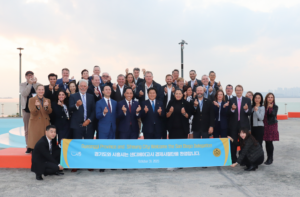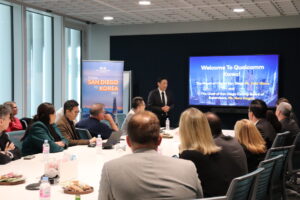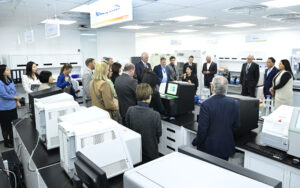Navigating trade uncertainty in a binational region
As tariff threats loom and the country teeters on the brink of an all-out trade war, we all wonder what it means for our binational region, the future of the popular USMCA, and the hundreds of thousands of jobs tied to global commerce in San Diego.
This will be a volatile period for the North American supply chains that enable this region to compete globally. We have been here before.
In all the economic development work we do in this region, we strive to do it binationally, as a metropolitan region of close to seven million bisected by an international border. We travel together on investment attraction missions to South Korea or Singapore; we advocate together in Washington, D.C. and Mexico City for better infrastructure; and we work every day with counterparts in Tijuana to help companies create deep and resilient binational supply chains in critical industries.
What we have learned is that in the midst of uncertainty, we should return to what we know to be true about this binational region:
- We know that our border economy, anchored by the busiest port of entry in the Western Hemisphere, has been a tremendous driver of economic growth, job creation, and competitiveness—not just for San Diego, but for America as a whole.
- We know that what we do here is not trade, it is co-production: a single component—in an automobile or a medical device—may cross the border six to eight times, with value added at each stop, before finally reaching its customer. This means that 40 percent of what we import from Mexico was made by American workers in the first place. For imports from China by contrast, that number is less than four percent.
- We know that this ability to regionally produce goods is a compelling reason why foreign companies invest here, and why local companies can compete globally and export their goods and technologies around the world, creating hundreds of thousands of jobs in this region alone.
- And we also know how critical these supply chains—in aerospace, electronics, semiconductors, and medical devices—are to the broader U.S. economy. Notably, 60 percent of all medical devices imported to treat patients in hospitals in Boston and Atlanta are produced in this region and cross this border every day.
- Finally, we know how important long-term investments in infrastructure—like Otay Mesa East or the Cross Border Xpress terminal—are to enhancing the remarkable economic engine we have created in this region.
Here in San Diego we have been finding solutions for decades, by working collaboratively to build border infrastructure, to facilitate trade and immigration, to fight crime and enhance education, and to create better outcomes for businesses, for consumers, and for communities.
The coming weeks and months will be bumpy—as barriers to trade and market access rise around the world—and they will be especially difficult for the 98 percent of U.S. exporters that are small businesses. Yet despite this turbulence, the overall calculus for American policy makers and global business leaders has been consistent for well over a decade: Regionalize supply chains closer to the customers they serve, and rebuild U.S. manufacturing capabilities in industries critical to national security and competitiveness. And there is no way to achieve those goals without relying on our North American neighbors. Even in the most extreme tariff scenarios, trade with Mexico and Canada would likely increase, but businesses and consumers would pay higher prices for the pleasure.
Our job in this moment is to be agile and creative in helping firms of every size—who have played by the rules and made significant investments in this country and its neighbors—to navigate uncertainty, continue to reach their customers and suppliers, and maintain jobs and supply chains in our most critical industries.

Nikia Clarke
Chief Strategy Officer, EDC; Exec. Director, WTCSD
Resources and action:
- Understand San Diego’s Foreign Trade Zones (FTZ) Program, which allows for duty free imports and warehousing. Learn more
- Apply by June 30 to WTCSD’s MetroConnect export accelerator program supporting small- and medium-sized businesses in going global
- Stay tuned for WTCSD’s upcoming Binational Trade & Competitiveness Report, launching Q3 2025
Need support? Contact our team.
EDC and WTCSD work directly with companies—free of charge—to help them grow in San Diego.


